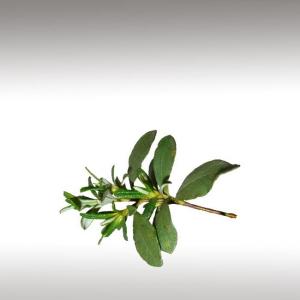
LABDANUM ESSENTIAL OIL (CISTUS LADANIFERUS) - ESSENTIAL OILS

BASE / GENERAL DATA
Information submited: June 4, 2015 Modified: March 13, 2018 By: OperaDreamhouse
Botanical Name: Cistus ladaniferus
Common Method of Extraction: Steam distilled
Part Typically Used: Aerial (leaves and twigs)
Color: Yallow - broun
Consistency: Thin
Perfumery Note: Base
Strength of Initial Aroma: Warm, sweet, dry, rich herbaceous
This resin oil ir rich warm, spicy and a bit lemon - like. It is a bit incense - like and slightly camphoraceous, yet with distinct balsamic note. Essential oil distilled from the resin or by directly distilling the leaves and twigs.
Cistus Ladaniferus is a species of flowering plant in the family Cistaceae. It is native to the western Mediterranean region. Common names include Gum Rockrose, Laudanum, Labdanum, Common Gum Cistus and Brown-Yyed Rockrose.
It is a shrub growing 1 - 2,5 m tall and wide. The leaves are evergreen, lanceolate, 3 - 10 cm long and 1 - 2 cm broad, dark green above and paler underneath. The flowers are 5 - 8 cm diameter, with 5 papery white petals, usually with a red to maroon spot at the base. The whole plant is covered with the sticky exudate of fragrant resin, the source of Labdanum, used in herbal medicine and perfumery.
Cistus Ladaniferus is particularly well suited to the continentalized Mediterranean climate, standing both long summer droughts and cold weather. In Spanish it is known as Jara Pringosa meaning "Sticky Shrub". In Portuguese it is known as "Esteva".
It is a popular ornamental plant, grown for its strongly resin - scented foliage and conspicuous flowers. Its leaves yield a fragrant oleoresin known as Labdanum, used in perfumes, especially as a fixative.
Cistus essential oil is steam distilled from the leaves of wild crafted Cistus Ladaniferus. There is some confusion, in the industry, about this oil because there are two other oils produced from the plant: an absolute that is solvent extractedfrom the flowers which is correctly referred to as an absolute, but there is another solvent extracted oil that is produced from the resinwhich is usually referred to as an essential oil but, is not anessential oil.
The resin is processed through solvent extraction, which usually will end up containing residual solvent in the oil. This should not be confused with the actual essential oil, which is steam distilled.
The Egyptians, after importing Cistus from Crete, used the resin as a perfume and incense. It is said that in Christ’s time, an incense was made with Myrrh, Frankincense and “Onycha”, later identified as Gum Labdanum, which is extracted from the leaves of Cistus.
It has been said that Rock Rose is the plant in the Bible referred to as “Rose of Sharon”.
In ancient times, Labdanum was collected by combing the beards and thighs of goats ans sheep that had grazed on the Cistus shrubs. Wooden instruments used were referred to in 19th century Crete as ergastiri a Lambadistrion ("Labdanum - Gatherer") was a kind of rake to which a double row of leathern thongs were fixed instead of teeth. These were used to sweep the shrubs and collect the resin which was later extracted. It was collected by the shepherds and sold to coastal traders. Many of the false beards worn by the pharaohs of ancient Egypt were made of goats hair which held together by Labdanum.
Common Method of Extraction: Steam distilled
Part Typically Used: Aerial (leaves and twigs)
Color: Yallow - broun
Consistency: Thin
Perfumery Note: Base
Strength of Initial Aroma: Warm, sweet, dry, rich herbaceous
This resin oil ir rich warm, spicy and a bit lemon - like. It is a bit incense - like and slightly camphoraceous, yet with distinct balsamic note. Essential oil distilled from the resin or by directly distilling the leaves and twigs.
Cistus Ladaniferus is a species of flowering plant in the family Cistaceae. It is native to the western Mediterranean region. Common names include Gum Rockrose, Laudanum, Labdanum, Common Gum Cistus and Brown-Yyed Rockrose.
It is a shrub growing 1 - 2,5 m tall and wide. The leaves are evergreen, lanceolate, 3 - 10 cm long and 1 - 2 cm broad, dark green above and paler underneath. The flowers are 5 - 8 cm diameter, with 5 papery white petals, usually with a red to maroon spot at the base. The whole plant is covered with the sticky exudate of fragrant resin, the source of Labdanum, used in herbal medicine and perfumery.
Cistus Ladaniferus is particularly well suited to the continentalized Mediterranean climate, standing both long summer droughts and cold weather. In Spanish it is known as Jara Pringosa meaning "Sticky Shrub". In Portuguese it is known as "Esteva".
It is a popular ornamental plant, grown for its strongly resin - scented foliage and conspicuous flowers. Its leaves yield a fragrant oleoresin known as Labdanum, used in perfumes, especially as a fixative.
Cistus essential oil is steam distilled from the leaves of wild crafted Cistus Ladaniferus. There is some confusion, in the industry, about this oil because there are two other oils produced from the plant: an absolute that is solvent extractedfrom the flowers which is correctly referred to as an absolute, but there is another solvent extracted oil that is produced from the resinwhich is usually referred to as an essential oil but, is not anessential oil.
The resin is processed through solvent extraction, which usually will end up containing residual solvent in the oil. This should not be confused with the actual essential oil, which is steam distilled.
The Egyptians, after importing Cistus from Crete, used the resin as a perfume and incense. It is said that in Christ’s time, an incense was made with Myrrh, Frankincense and “Onycha”, later identified as Gum Labdanum, which is extracted from the leaves of Cistus.
It has been said that Rock Rose is the plant in the Bible referred to as “Rose of Sharon”.
In ancient times, Labdanum was collected by combing the beards and thighs of goats ans sheep that had grazed on the Cistus shrubs. Wooden instruments used were referred to in 19th century Crete as ergastiri a Lambadistrion ("Labdanum - Gatherer") was a kind of rake to which a double row of leathern thongs were fixed instead of teeth. These were used to sweep the shrubs and collect the resin which was later extracted. It was collected by the shepherds and sold to coastal traders. Many of the false beards worn by the pharaohs of ancient Egypt were made of goats hair which held together by Labdanum.

SPIRITUAL PRACTISES DATA

MEDICINE / HEALTH DATA

BEAUTY / COSMETICS DATA

FOOD / COOKING DATA
COMMENTS
No comments.
Newest mixtures containing Labdanum Essential Oil (Cistus Ladaniferus):

Balm for mature skin
June 4, 2015


